‘Tis the season for ar omatic herbs
View(s):In the fifth and final instalment in our series on edible leafy greens, we feature ‘Herbs’
By Dr. Nirmala M. Pieris
Christmas will soon be with us and whether you are trying out new ideas or the age-old traditions for festive cooking, leafy green herbs are an indispensable requirement in your roasts, bakes and other Christmas dishes. The wonderful aromas that green herbs evoke will not only make your food taste amazing but will also give your home a festive fragrance. We do use herbs when we cook all through the year, but at Christmas time these exotic herbs add such a special pleasing taste to our festive table.
Did you know that common symptoms associated with a heavy holiday meal such as indigestion, gas and bloating can be avoided by cooking with the right mix of herbs and spices? Always use fresh herbs for maximum flavour and health benefits. Surprisingly, these delightful herbs can be easily grown in your home garden or even on a balcony, keeping in mind that most prefer hot, sunny conditions. The common herbs are now also freely available in supermarkets.
Herbs carry unique antioxidants, essential oils, vitamins, minerals and other plant derived nutrient substances. These constituents provide various benefits that include the strengthening of the immune system, maintaining healthy skin and hair, reducing the risk of Alzheimer’s disease, helping to reduce blood sugar levels and cholesterol and are also beneficial in treating arthritis. Although small amounts like those used to flavour food are not considered large enough to have a major effect on the body, regular addition of the leaves to your food will allow your body to derive accumulated benefits from the organic compounds and unique phytochemicals present in the leaves.
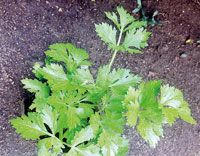 Celery
Celery
Celery, Apium graveolens in the family Apiaceae is a marshland plant where both the stalk and leaves are edible. Celery has a mild acid content that gives a tart, tangy flavour with a flat, watery aftertaste. However, celery is also used for its crunchy texture in salads. It detoxifies the body and is often used in weight loss diets as it provides low calorie dietary fibre bulk. Celery leaves make a great addition to stir-fries and soups and are also good in stuffing. With a herby butter, celery goes well with roast ham.
 Chives
Chives
Chives, Allium schoenoprasum in the family Amaryllidaceae is an ever-green herb that adds a hint of pleasantly subtle, onion-garlic flavour to savoury dishes, Similar to onions and garlic, sulphur containing organic compounds give chives their flavour with the major contributor being dipropyl disulfide. Chives aid digestion and let your digestive system work fully. Toss chives nto a dish at the last minute, because heat destroys their delicate flavour. Thinly slice them to maximize taste. Chives are great with eggs, baked potatoes, spreads and dressings. Scrambled egg with chives is great for a Christmas morning rushed breakfast.
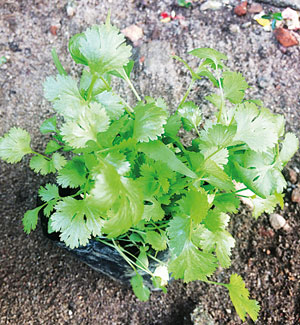 Cilantro
Cilantro
Cilantro, Coriander, Coriandrum sativum in the family Apiaceae brings a fresh, nearly citrusy flavour to foods with the main component being 2-decenoic acid and many aldehydes. While some think that cilantro tastes amazing others may hate it and often attribute this to a soapy aftertaste. Cilantro haters are those with an olfactory receptor gene that picks up the smell of aldehyde chemicals that are found in both cilantro and soap. If you like cilantro it is good in soups, sauces, pasta, in marinades and also a great addition to a green salad. Moreover, it is indispensable for biryani and its accompaniments.
 Basil
Basil
Basil, Ocimum basilicum in the family, Lamiaceae also called the ‘king of herbs’ with a menthol aroma is one of the most popular of the culinary herbs. It is highly fragrant with a pungent and peppery taste that evolves into a slightly sweet flavour. Over 15 varieties of basil exist with the commonest being the large-leafed basil. The major compound that contributes to the flavour and aroma of basil is estragole together with linalool. In pasta, pesto, chicken or shrimp, there is an array of possibilities for cooking with basil. During this Christmas season serve grilled chicken with a basil dressing- it will be delicious.
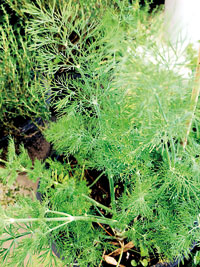 Dill
Dill
Dill, Anethum graveolens in the family Apiaceae is a herb with a pleasant anise-like flavour. The major compound that contributes to the flavour of dill is carvone. The herb also contains eugenol, a volatile oil that has potent antiseptic and anesthetic powers. It can also reduce excess gas and relieve flatulence. Dill is used to enhance the flavour and taste of vegetables, chicken, fish, meat dishes and also used in the preparation of soups, and sauces. Freshly chopped and sautéed dill is a great addition to a green salad for the Christmas meal.
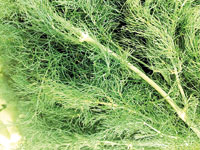 Fennel
Fennel
Fennel, Foeniculum vulgare in the family Apiaceae is composed of a white or pale green bulb from which closely superimposed stalks that are topped with feathery green leaves. The bulb, stalk and leaves are all edible. Fennel has a slightly sweet and spicy anise flavour that comes from the compound anethole. Fennel is helpful in anemia and menstrual disorders and also facilitates digestion and eliminates bad breath. It is good in stir fries, pastas, braises and also as a garnish. Fennel is a versatile ingredient that goes gorgeously with baked fish or a potato and leek gratin.
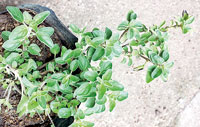 Marjoram
Marjoram
Origanum majorana in the family Lamiaceae has a delicate sweet-flavour, and subtle pungent citrusy taste. The characteristic flavour of the herb is attributed to sabinene hydrate while other terpene compounds also contribute to the aroma. Marjoram though often confused with oregano is different as it is milder, but yet has a variety of psychological and neurological benefits. It is used in rice dishes, garlic spreads, soups, pasta sauces, salad dressings and will also be perfect with roast turkey or glazed carrots for Christmas dinner.
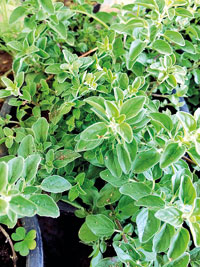 Oregano
Oregano
Oregano, Origanum vulgare, in the family Lamiaceae sometimes referred to as wild marjoram has a warm somewhat bitter taste with a tint of sweetness. Carvacrol is responsible for the pungent odour of oregano. Traditionally, a leaf of oregano can be taken alongside a meal to aid digestion. Oregano is often the main herb in pizza sauce and also used in tomato dishes, salads and with grilled meats. It is good in the stuffing for turkey and is great in a sandwich with leftover turkey.
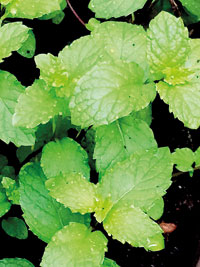 Mint
Mint
Mint, Mentha longifolia in the family Lamiaceae is a fast-growing, herb extending its reach along surfaces through a network of runners. It is estimated that over 15 species of mint exist with the exact distinction still being unclear. The major flavor compound in mint leaves is menthol. Mint is used to garnish cold drinks and to make mint sauce or jelly. Mint sauce is indispensable with a rack of roast lamb. An essential in any festive mojito, mint is an important herb for Christmas. The addition of some fresh leaves to boiling water is a good refresher between courses to cut through a heavy meal.
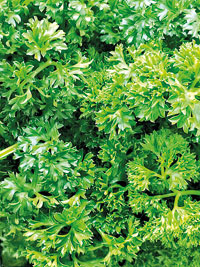 Parsley
Parsley
Parsley, Petroselinum crispum in the family Apiaceae comes in two distinct varieties, the curly parsley that has a milder taste and the flat leaved variety. 1,3,8-p-menthatriene is the major compound in parsley leaves. Other compounds include myristicin and limonene. Parsley helps flush out excess fluid from the body, thus supporting kidney function. Parsley is used in soups, sauces, and salads, and lessens the need for salt in soups. It is also a perfect garnish for the Christmas turkey and accompaniments.
 Rosemary
Rosemary
Rosemary, Rosmarinus officinalis in the family Lamiaceae is a needle-shaped herb with a tea like aroma and a piney flavour. Alpha-pinene is one of the major compounds in rosemary along with other members of the monoterpene family of compounds. One of the earliest documented uses of rosemary is said to be as a memory booster. It can be used for cooking, baking or decoration. Rosemary tastes good in chicken, lamb and other meat dishes plus soups, sauces and potato recipes; it is also excellent with roasted chicken or glazed ham.
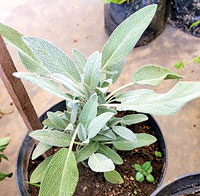 Sage
Sage
Sage, Salvia officinalis in the family Lamiaceae is a shrub with greyish leaves with a fragrant aroma and an astringent but warm flavour. The main chemical compound that provides its flavour is manool, as well as eucalyptol and thujone. Sage goes well on a variety of dishes, from poultry and pork to pizza, salads and omelettes and takes a starring role in stuffing, famous for being a partner to pork, though it can also be used in richer meats like goose, as the herb helps cut through the fat.
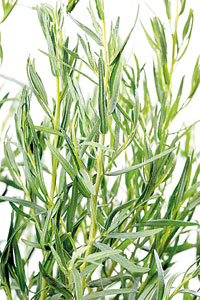 Tarragon
Tarragon
Tarragon, Artemisia dracunculus in the family of Asteraceae, has a slight licorice flavour reminiscent of anise due to the presence of estragole. Tarragon is particularly suitable for chicken, fish and egg dishes. It is also good in creamy sauces and this Christmas try roast chicken with tarragon or a seafood salad with a creamy tarragon dressing. Fresh slightly bruised sprigs can also be steeped in vinegar for a flavourful addition to turkey sandwiches.
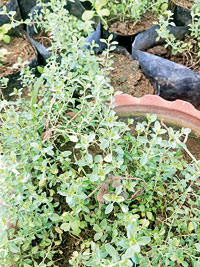 Thyme
Thyme
Thyme, Thymus vulgaris in the family Lamiaceae has a piney and peppery taste with bitter, slightly lemony and minty notes. Thymol is the compound that provides the distinct flavour of thyme. In combination with parsley and bay leaves it makes up the French combination of herbs called ‘bouquet garni’ used to season stock, stews and soups. Thyme can be sprinkled over eggs, cheese dishes, vegetables, fish, or poultry. This season if roast pork or turkey is on the menu, jazz it up with a thyme and onion or thyme and parsley stuffing or try a dressing with parsley, sage and thyme.


